Being an international student from Amman (Jordan), I have been subject to scare after scare, as a result of biased and falsified main media stories being shared in the West. The heartbreaking chaos that has taken place in the Middle Eastern area; war, revolutions, extremism, occupation and social injustices have affected thousands of refugees, my family, friends and the people that I proudly share a culture and home with. My inspiration formed from main media articles in comparison to social media articles that I have collected and read over the last 2 years, from both Amman and Cardiff. Through the use of Arabic calligraffiti (a method combining calligraphy and graffiti), collage and some sculpture, I have created work that is a personal emotional response, including my honest thoughts, commonly used phrases and poetry as a therapeutic way to deal with the articles in the media and bring the lives of the innocent to attention. Additionally I aim to give others an insight into the reality of the issues and facts about the innocent lives affected and a perception Western media will not portray, hopefully creating more sense of a global community rather than an ‘us vs. them’ way of thinking.
Category Archives: Contextualisation Third year
5 posts; Field contextualisation 3rd year
5) Contextualisation: Talk and tutorial with Artist MArk Gubb
British artist Mark Gubb spoke at my university and I had the opportunity to speak with him afterwards in a one on one tutorial ( was keen on getting someone news perspective on my work; someone who knows nothing about it). His work is often politically related or includes social injustice issues in society.
One of Marks performance/installation film about Peter Fechter who was murdered at the Berlin wall. This was inspiring to me had the same qualities, impact and confusing stressful environment I wanted my work to share as well.  His suggestion was to use the QR code patterns that I had generated as a camouflage print on the tent fabric that I use, that confuses the audience but relates to the use of QR codes and social media interactions (as I mentioned in my documentation posts).
His suggestion was to use the QR code patterns that I had generated as a camouflage print on the tent fabric that I use, that confuses the audience but relates to the use of QR codes and social media interactions (as I mentioned in my documentation posts).
It became clear to me after this discussion with Gubb that I have the ability to make a difference, small but significant, through the use of my art and my passion for making art about social and political issues.
4) Contextualizition: Bristol – Palestinian museum
While I was visiting galleries (such as the Death exhibition in the Bristol Museum and Art gallery) I stumbled completely by accident on a little sign on a door, that there was a pop up museum held by Palestinians activists on the roof. Walking up the 5 flights of steps, are plenty of articles, facts and photographs covering the walls. I was so positively surprised to be greeted by a smiling Western looking lady, wearing the Hijab headdress who discussed the way the museum worked and that it is run by activists. A group of people sat drinking tea in the corner greeted me as i proceeded to walk around taking photos of thousands of articles and photographs, leaflets and protest banners, and even a small section of handcrafted goods made by Palestinian women in the older villages (might I add, villages where my family was raised and some members are actually from). It brought tears to my eyes but gave me the push I needed. I realised I was then considered an activist when one of them began to discuss the impacts of social media on the issue of raising awareness and made some new connections. That was the first time I had considered my self to be part of the activist community.
The influence and push I needed was inspired by these great people running the museum off little funding and donations, giving a voice and ensuring more hear about the truth and learn about this very current, ever continuing, global loss.
3) Contextualizition: Laura Provost & Anne Hardy
Through looking at Laura Provosts work I have decided I will neither be making a minimal or excessively messy environment in my work. Provosts work uses objects to speak for themselves in a composition, which gives a bigger sense to an overall theme throughout the environment. I wish to use the trinkets and found objects in my work, and specifically selected items like the Jordanian and Palestinian headscarfs (culture references), the worry beads (an older generation reference) and evil eyes (superstitious belief reference), all of which allows the viewer to interpret their own narrative from the objects without giving the context of the work away.


Anne Hardys work is similar to Provosts in which they both use objects to fill and create en environment that is surrounded by objects, which each have their own voice, suggesting what the work is about without giving away too much of the context or narrative of the work.
“Anne Hardy’s photographs picture depopulated rooms that suggest surreal fictions. Working in her studio, Hardy builds each of her sets entirely from scratch; a labour-intensive process of constructing an empty room, then developing its interior down to the most minute detail. Using the transient nature of photography, Hardy’s images withhold the actual experience of her environments, allowing our relationship with them to be in our imagination.” Saatchi Gallery website.


2) Contextualisation: QR codes; obsessively collecting articles
Part of my research process and the reason for my drive and passion in my practical work has been the articles I read, share, videos I watch, people I speak to, mainly on social media sites. They break my heart but make me feel like I need to be heard and my contribution is sharing this all through my art and to educate and be as honest as possible about the reality of the chaos occurring even as you read this. That is the point I’m trying to make, is right now, as I type this, as you read it, this is all still going on. This is my day to day, it’s heart breaking and I have had many a heated conversation online with people who have other views on the matter, breakdowns and plenty of tears. I grew up with this and this is me documenting it all because I need to, and expressing this all through my art work.
The first photo is one of my studio space wall when I began to save and collect hundreds of articles, images, links, saying, quotes and other random bits of information; anything I could get my hands on related to the issue, so I could give the best and most honest point of view through my work, hopefully influencing others to do the same. Although it changes on nearly a day to day basis, it is a wall where others can constantly find new information, and a visual mind map for myself.
The frustration I feel, I let go of through reacting to these pieces and responding to them through my painting and calligraffiti.

These are just some examples of the screen shots that I have saved of articles that I have saved and read and shared. As emotionally triggering this can be sometimes, my social media is full of posts like this and I will always make a point of sharing them.
I cannot express my frustration when it comes to doing more in order to help. I have thought and researched and attempted twice to get into the refugee camps back at home in order to just lend a helping hand in any way shape or form; however sadly through plenty of red tape and months of waiting and trying, I was unable to visit. I share my artwork and the articles so I can make others aware of the issues. I feel like my mission is to make others remember that its not ‘us vs. them’ it’s a global community.
Although these are graphic, they are sadly the honest truth.
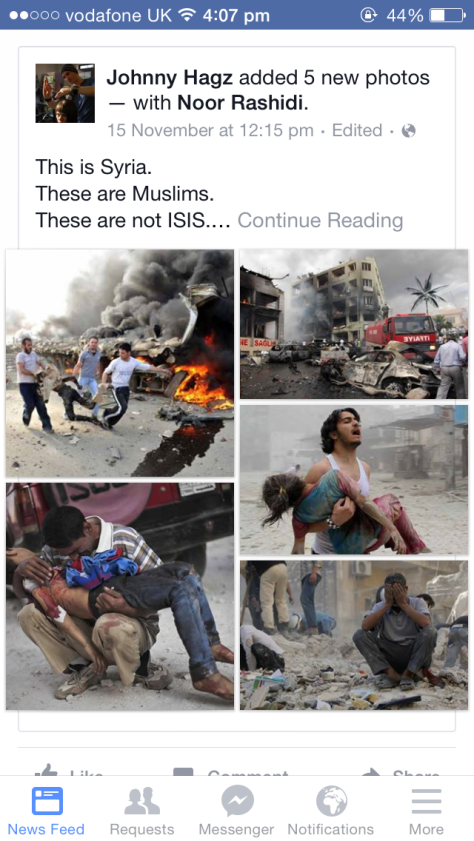
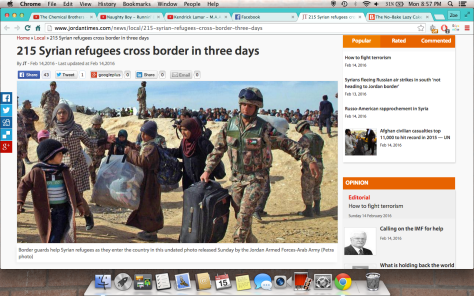
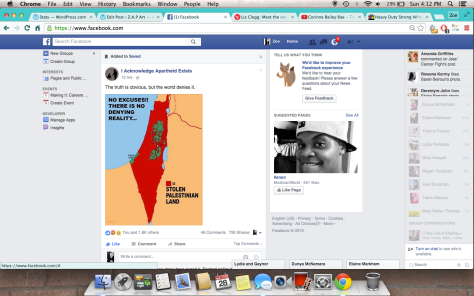

1) Contextualisation: Ai Wei Wei
Ai Wei Wei is a Chinese artists known for his installation work regarding social injustice issues. The powerful piece that intrigued me in his work was the one seen below. The 90 tonne iron rods are debris from an earthquake that occurred in China causing thousands of injuries and fatalities, while the Chinese government did not release a report or the names of the victims affected in the catastrophe. The rods were painstakingly straightened by hand and laid out to replicate the contours of the landscape where the earthquake affected. It is described in Guardians article, “It is I think the heaviest work we’ve ever put in our galleries here,” said co-curator Adrian Locke. “Aside from the technical challenge, it is a very sombre and sobering work when you see it, it has this kind of power and silence about it … it bears a real sense of loss of life.”
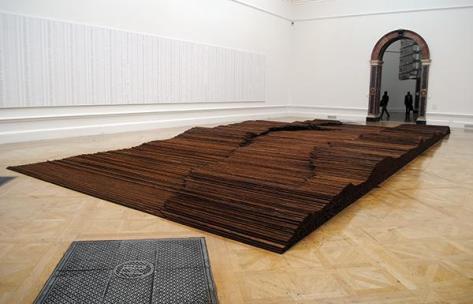
This is another piece done by Ai Weiwei where he wraps the Columns of Berlin’s Konzerthaus with 14,000 Salvaged Refugee Life Vests.
http://www.thisiscolossal.com/2016/02/ai-weiwei-konzerthaus-refugee-life-vests/
“Although thousands of the life jackets can now be seen in Berlin, this does not begin to account for the thousands of jackets that remain on the shores of the Greek island, pointing to the number of refugees who have passed through the island. Since last December Ai has shared dozens of images of refugees who have come to Lesbos on his personal Instagram account, including this image of a mass of life vests left behind.
The temporary art installation was created for the Cinema for Peace gala which took place February 15, 2016.”
This piece has inspired me to show facts in a shocking format throughout my work, numbers and subtle use of an object in its simplest form, can actually be in my opinion one of the most powerful ways of get an idea across through art.

5 Posts: Contextualisation 3rd year
24/7; Obsessively Collecting
Throughout my research I realised how much it has taken an emotional toll on me. I am constantly researching, looking up, reading and watching news update after news update. By immersing myself in all of the news I can’t help but feel Obliged to document as much as I can, incorporating it into my work, by using QR codes linked to articles or photos, which I will imbed in my collages. Through constant stimulation I plan to take advantage of news that just at my fingertips on my phone and include the actual screen shots into my work.
These are just some of the large collection that I have seemed to have collected over the past few weeks. (my space below; a visual mind map of all of the articles, artist influences and mental notes I have collected.) The collecting has been a huge part of my project and is what tends to be my biggest inspiration and main drive to continue to work, on such a hard and emotionally heartbreaking subject to me.

Artist research; Shadi Al Zaqzouq
Shadi Al Zaqzouq was able to turn something hideous and painful into something beautiful again. Although the reality of the bullet holes and shrapnel damage on the building are haunting, Zaqzouq recreates the famous painting by Gustav Klimt ‘The Kiss’ on the damaged building, using the damage as the detail of the piece. This is something I wish to incorporate in my work; the idea that nothing can ever be fully repaired or fixed once damaged, but still holds sentimental value; which in itself is something beautiful; turning ‘junk’ and found damaged objects into art.
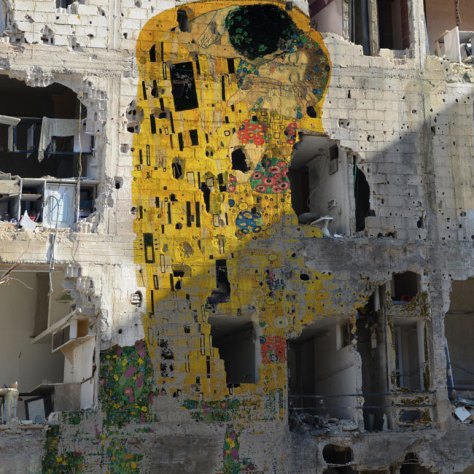
This piece by Zaqzouq is a collection of old cardboard boxes with paintings in the bottom of each to create a large collage of his memories and experiences. I had already started to collage with cardboard boxes, by painting and transferring images onto them using text and pictures from old newspaper articles, when i stumbled across this piece of his. I love the use of the boxes as ‘windows’ into snip-bits of life, as I want my boxes to have this effect of what life is really like for example, behind the Palestinian wall.















